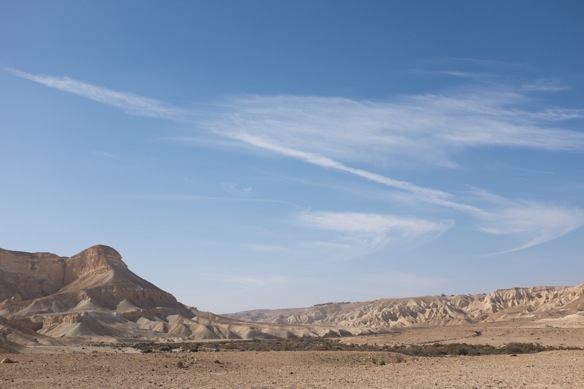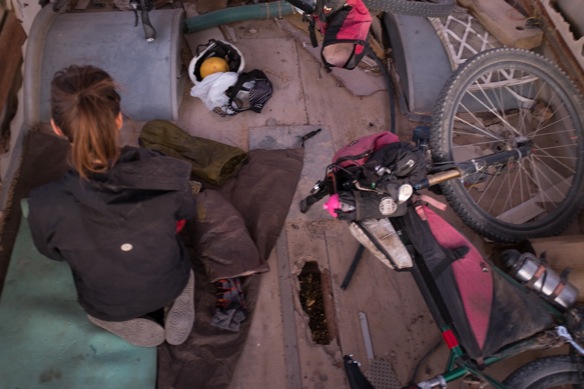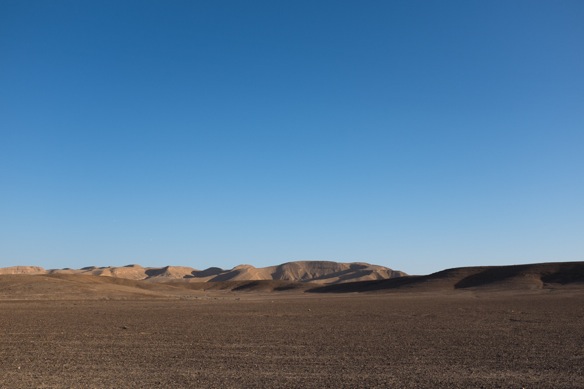
The plan is to meet in Ezuz on Thursday night, near the border with Egyptian Sinai. We’ll ride for two days through a southwestern slice of Israel normally reserved for artillery training and ranging antelope, and not much else save for a single road crossing with a free campground and a water tap. Israelis call this “the backyard”. When we arrive, I ask about the terrain even through I’ve studied the GPS track. “Should be mostly dirt roads”, Ilan says.
Ilan and Danny are coming from the city, escaping busy lives for fifty something hours of touring and training in preparation for the upcoming Holyland MTB Challenge, a north-to-south cross country endurance race set to depart in early April. Ilan is, as he calls it, a shadow organizer of the event, who is proud of the route, the website, and the chance for others to ride and race across Israel. Both Ilan and Danny rode last year– mostly together– and both scratched from the race after five days. Achilles tendons worn by pushing bikes uphill is the shared excuse, although they weren’t on track to finish the 800+ mile route within the 11 day cutoff. Both are keenly working to improve several underrepresented mountain biking skills: bike pushing, sleeping comfortably and efficiently outside, and learning to rest and relax while stopped outside gas stations and grocery stores.
Lael and I plan to arrive in Ezuz by way of dirt roads from Sde Boker, which is a quick ride on hardpacked dirt with tailwinds. It is Thursday afternoon and the area marked “No Tresspassing! Firing Area”, is silent. The Israeli weekend is Friday and Saturday. We arrive in Ezuz four hours before Ilan and Danny will arrive, but just as two other riders depart the cafe. One rider is named Ilan. For a minute, I’m confused. What is your last name? “Rubenstein”, he clarifies. Ok, not the Ilan we are meeting, but he knows that the other Ilan is coming. How is it that on the same day two bikepackers named Ilan are riding across the same desert tracks from Ezuz, a tiny community of only twelve families? This Ilan assures me that the coincidence was discovered days ago, via email or forums. Since the route is only passable on weekends, and the desert is only palatable in the cooler months, and the HLC is fast approaching, the coincidence is understandable. This is our second major introduction to the active bikepacking community in Israel. The first are the dozens of emails I’ve received from riders who have offered assistance, shelter, and routing through their country. Lael and I remark that South Africa was supposed to be real hot about mountain biking. I’d never heard of mountain biking in Israel, but I’ll be sure that you do. These people actually ride bikes!
Danny and Ilan arrive in the evening as scheduled. After introductions and a beer, we settle into a nearby grove for an early rise, agreed not to come from an alarm– we’ll meet in the morning when we wake. Seems logical. You never know who you’ll meet on the internet.
Morning brings a casual pedal up-drainage, slowly trending steeper through gravelly wadi and hard dirt riverbank. The effort comes from the upper legs, from deep muscles, but is not entirely exhausting for us. That is, Lael and I have been at this for over six months, and we’ve been sucking air tackling steep climbs and gravelly wadi since arriving in Eilat. Danny and Ilan are more accustomed to the hard dirt trails up north, and probably office chairs, I think. They describe spacious pine forests and manicured trails in the center of the country.
Nearing our expected midpoint lunch stop– a campground with water– we split the group in half. Lael and I ride onward to rest at the campground. Lael wants to go for a run, so we agree to get there first. Danny and Ilan rest in the shade of a river bank, agreeing to meet a short time later. Danny arrives at the campground as Lael is off running. We talk. Lael returns. The three of us talk, fill waters, lube chains. Ilan is missing. Danny and I jump on our bikes, now several hours since arriving here for our rest. The sun is getting low. We meet Ilan just over the first rise, pushing his bike. He has pushed for 6km, which accounts for some of the only easily rideable dirt road of our half-day wadi ascent, not that it was easy. But it was rideable.
Under the shade of stone walls and palm fronds– a free camp area provided by the Israeli government– we clean out the inside of his tire. Danny has a tube that doesn’t have any holes in it. Ilan has been carrying his tube for years– never needing it, until now– discovering it has since been damaged by two years of transport on a bike. Flipping his Trek Superfly right side up, we consult the maps loaded to memory and agree to ride the paved road to Mizpe Ramon. There, we eat, we sleep, and restart in the morning. Most importantly, we alter our course across the desert in trade for some fresh singletrack. A section of the Israel Bike Trail from Mizpe Ramon to the ruins at Moa (near Zofar) has recently been built and signed, the newest piece in an expansive cross-country trail project which mirrors the Israel National Trail. And, we’ll descend all day. At least, we’ll finish the day lower than we started.
The IBT is a delicacy in a land of rough cut 4×4 tracks and sandy wadi. The modern, durable trail is cut from cliffbanks, sinuous and signed for miles. Intermittent sections of doubletrack offer mental respite from the trail, although in total, the IBT is suitable for novice to intermediate riders with strong fitness. This is not the kind of trail that will scare first time bikepackers. It will embrace them, leaving a smile. It is a welcomed resource in a country already densely woven with riding and walking. Israel is a great place to ride, and it’s getting better. Events such as the Holyland MTB Challenge are working hard to make that fact known.
Swinging from canyon wall to canyon wall, traversing the sandy wadi with spinning legs and speed, the IBT shuttles us back down to sea level, to a series of ancient ruins, to a McDonalds on a paved road, to a bus back to Tel Aviv, and to the end of our brief partnership. Ilan washes in the public bathroom, exiting almost as if he has showered wearing flip-flops and wet hair. Lael and I are quick to buy and finish an expensive beer from the convenience store. Sharing a few more pedals strokes away from the McDonald’s, we turn back upstream toward Sde Boker, now 11 feet below sea level in the Aravah Valley. Danny and Ilan continue to the bus stop on the roadside.
Arriving at Sde Boker, about 1500ft.

David Ben-Gurion, the first prime minister of Israel, lies here. The community also claims a university in an idyllic mountain desert landscape. Many rural Israeli communities were built in the 1950’s and 60’s, reminding me of the many large university building built during this era in the US. I think of SUNY Albany. The designs are efficient, square, concrete.


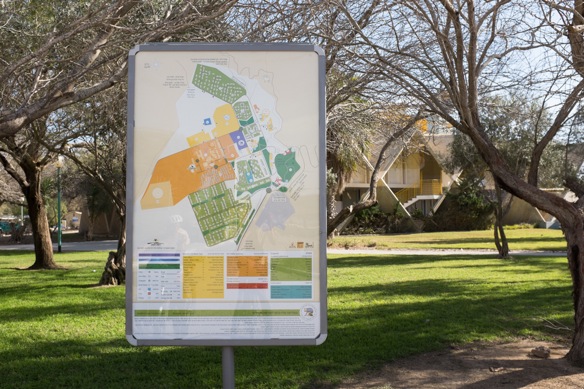
Sde Boker has a small bike shop, guarded by a tough group of local riders.

To Ezuz. They say it rained the week before we arrived. Nothing but sun for us, although nights are cool and breezy.

Ezuz. Singlespeeds, Revelate luggage, and some capable riders. Ilan Rubenstein, on the right, had kindly contacted me via the blog prior to our meeting. I just didn’t know we’d meet like this. We wait for Danny and the other Ilan.

Pizza and beer in the middle of nowhere, Israel.

In a stack of National Geographic magazines, I spot a series of issues from 1973 and 1974. I know what I am looking for: “Bikepacking Across Alaska and Canada” by Dan Burden, May 1973. This is the earliest use of the word bikepacking I’ve seen in print.
For Velo Orange fans, you’ll be excited to know the article which follows it is about the wild horses of the Camargue preserve in Southern France. The Camargue is the name of a new Velo Orange touring frame with clearance for full-size 29″ tires. An unnamed disc variant is soon to be released, although the styling breaks from the traditional European elements Velo Orange has championed for so long.

Many Israelis speak excellent English. Even so, there is a unity in familiar equipment and sleeping on the ground.


As promised, “dirt roads”. Kinda soft for 2.2″ tires, in my opinion. Thinking about coming back to these parts with fatbikes some day.

Some riding, some walking. Good training for the HLC.





The track finally climbs out of the wadi onto a hard dirt road. We ride to fresh water, leaving Danny and Ilan behind.



Danny and I return to find Ilan, pushing his bike. The rear rim skips across angular rocks, the deflated tire battered by months of use and six kilometers of pushing.




A quick tour of the tar road to Mizpe Ramon.


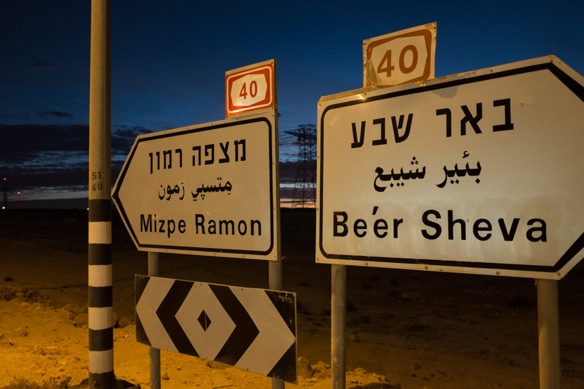
Digital and caloric refuel at the gas station in town, before rolling less than a kilometer down the road to a free public camping area for the night.



The small forest features fresh water, toilets, and trash cans. A youth groups tends a fiery blaze for a few hours, until bedtime. Free camping is awesome.

The next morning, we arrive at the edge of town, at the edge of a cliff, at the edge of a crater, called makhtesh in Hebrew.

Fresh IBT, all day long.

These non-impact craters are the largest of their kind in the world, and the Hebrew word is accepted by the geologic community to describe them. A single water gap drains each crater. There are three prominent craters in the region.


Danny removes a broken spoke which has wound itself into the back of his cassette, hindering the freehub. Both Danny and Ilan are part of a MTB group– 4 Epic– which organizes local races and rides. Israelis are organized and efficient.

High quality trail, simple and durable, perfect for multi-day rides. Would you please sign it in the other direction? The trail is currently only signed north to south.

“Get off bikes!” Yeah right.



A gasline road rolls across the basin of the makhtesh. On their second day from town, and from office chairs, these guys are finally finding their stride. Less than two months to go! We talk about new gear choices for this year, and new strategies. Ilan is walking the 11 flights of stairs to his office, preparing his hike-a-bike legs. Rubber soled shoes are to be used instead of the hard plastic soles found on many performance shoes.



Some of the trail is “green circle”, which makes Lael grin.


Ilan rides a full-suspension Trek Superfly with a mix of Revelate Designs and Nuclear Sunrise luggage. The framebag space of a hardtail would be nice, he says. The modular waterproof Revelate Terrapin setbag allows easy gear removal at the end of the day. An SP dynamo hub powers an Exposure headlight, and soon, also the GPS. A Lezyne backpack carries extra food and water.
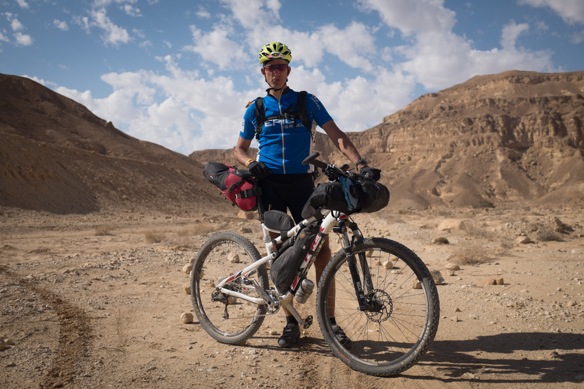

Danny is riding a hardtail Trek Superfly with a Jones Loop H-bar, Revelate Designs luggage, and a Wingnut pack for extra food and water.

Up, but not much.


And down. Way more flow than the previous day.

Finishing with a short downstream wadi ride, we miss the final section of IBT singletrack to Moa. We’ll have to come back with our Alaskan friend Christina for this piece of trail. She arrives next week.

Retro-modern: checking the bus schedule aside several thousand year old ruins.

The end of our partnership. Back to our real lives.



Back to Sde Boker, by the now-familiar HLC route over the Marzeva climb.


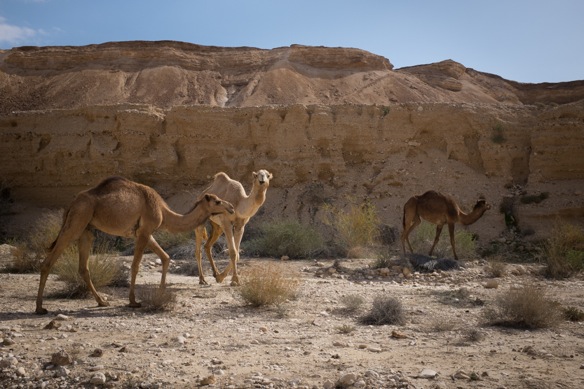


Camel tracks.


Back up to Sde Boker, just 1500ft above sea level. Our next day of riding will take us all the way down to the Dead Sea, more than 1000ft below sea level.

Thanks to Danny and Ilan for a great weekend on the bike.
Thanks to Tamir and Adi for hosting us in Sde Boker.
Ilan– the other one– we may still see you in Eilat.











































































